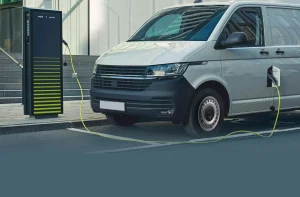1. Introduction
Electric Ambulances; As healthcare systems are moving towards environmental sustainability, the focus is now being more on innovative transportation concepts, especially used in the healthcare industry. When we talk about transportation services in the healthcare industry, the primary concern is almost always moving the patients from one place to another in an emergency or a scheduled manner. The two key aspects for modern healthcare transportation are environmental sustainability, keeping in view the requirements for clean energy, along with efficient and reliable emergency services. Further, both these aspects also play a crucial role in the ambulance design process, and both these aspects tend to be interdependent on one another throughout the lifecycle of the ambulance. The evolution of ambulances varies from the simplest vehicles, adapted to transport patients to and from hospitals, to a veritable mobile hospital. Even today, more than twice the percentage of the fleet in any modern European country is produced to the B-standard. There is no doubt that the improvements in electric vehicle technology will assist the evolution of the need for clean energy in the infrastructure of a mobility system.
This report provides a detailed analysis of electric ambulances. The upcoming sections are designed for the complete analysis of electric ambulances. This paper discusses the key specifications of electric ambulances, starting from the vehicle design. The next section talks about the major challenges faced by electric ambulances that have already been in use. A detailed analysis of the possible solutions is discussed in the section on challenges in electric ambulances. The section also talks about the benefits of using electric ambulances.
2. The Need for Electric Ambulances in Healthcare
Ambulances used as emergency vehicles in the healthcare sector, under private or public control, use fossil fuels in the form of diesel that lead to severe air pollution and account for increased greenhouse gas emissions. There are increasing concerns from all sectors, especially over the issue of carbon footprint from vehicles equipped with internal combustion engines. As a result, strict rules and regulations are implemented for new vehicles equipped with features that reduce the amount of exhaust emissions. Initially, due to the exorbitant cost of electric vehicles, very few automakers could develop completely built units or electric vehicles in India. Gradually, awareness of the electrification of automobiles was propagated to such an extent that the transition from internal combustion engines to electric vehicles drove the concern of environmental pollution, the emphasis of the governments of different countries, especially India, the European Union, the United States of America, and many other countries. Obviously, the focus of the paper is on the unavailability of electric ambulances and the technical issues and challenges in India.
To protect the atmosphere from degradation and to accomplish the goal of a country with respect to carbon reduction, a large amount of carbon dioxide produced by internal combustion engines must be curtailed. Therefore, any type of electric vehicle, plug-in hybrid electric vehicle, or hybrid electric vehicle including internal combustion engine vehicles can be developed. In so far as electric ambulances are concerned, several benefits exist if they are deployed with the appropriate parameters, besides their ability to align with the owner’s sustainable policy. These electric ambulances are low in maintenance costs, particularly in terms of fuel, as they are replaced with electric charging. When emergency vehicles like ambulances are electrified, it resolves all sorts of problems. On a rough estimate, one can substitute every 10 power units owned by a fleet. Therefore, there is a dire necessity to have a prototype developed.
2.1. Environmental Benefits
Many healthcare organizations and patients choose electric vehicles due to their environmental advantages. Ambulances and healthcare shuttles are incorporated into healthcare systems, making the adoption of electric vehicles attractive for these transport systems. To create clean, healthy, and quiet cities, local governments face pressure to clean their air by reducing tailpipe emissions and being more sustainable in their approach to transportation. Ambulances that produce zero tailpipe emissions are vital to improving air quality. Additionally, electric ambulances reduce noise pollution in urban settings during unscheduled operations and hospital transport services. The noise level reduction of electric ambulances improves the working conditions for healthcare providers and enhances the recuperation of patients in the hospital.
Electric ambulances align with many hospitals’ and governmental sustainability goals. Electric vehicle technology shows the ability to reduce greenhouse gas emissions by 75% compared with gasoline ambulances. Electric ambulances help meet sustainability goals.
2.2. Economic Benefits
2.2. Economic benefits.
Electric ambulances are cheaper to refuel compared to petrol or diesel vehicles; they may lead to long-term cost savings. The registration and maintenance costs of electric vehicles (EVs) are relatively less compared to petrol or diesel vehicles because EVs are built with far fewer moving parts, so they require less servicing. The scheduled maintenance costs for an electric vehicle are on average 35% less than the maintenance costs for gasoline vehicles. The same is true for diesel-powered vehicles. Additionally, the ambulance could benefit from government incentives or grants. Moreover, the electric ambulance may have a different associated insurance premium, as insurance companies increasingly offer discounts to electric vehicle owners due to the reduced risk profile of electric vehicle ownership. Ultimately, the advantage in terms of costs depends on several factors, including the price of fuel and the customer’s financial conditions.
Automating an ambulance could result in a long-term cost-saving strategy. Electric ambulances are cheaper to run than other types of ambulances. This is mainly because running an electric ambulance is more cost-effective than diesel ambulances. Since electric ambulances run on electricity and natural gas, they can cover a distance of miles per 1 kWh of electricity. That is quite efficient; however, in contrast, gas-powered ambulances can save 29 miles per 1 gallon.
3. Technological Advancements in Electric Ambulances
In the last decade or so, new technological advancements and a shift in the creation of batteries have brought electric vehicles to the forefront. As the efficiency and life cycle of lithium-ion batteries progress, newer electric vehicles can offer a faster range. Moreover, these vehicles can be charged in relatively less time. Paramedics are working under tight schedules, and an ambulance shouldn’t keep running out of charge on their watch. Lithium iron phosphate and lithium-titanate batteries are now also being used to meet our speed and duty cycle requirements. With a BMS, even these technologies have fewer chances of fast degeneration and improved long-term sustainability. The relatively smaller powertrain and radial function of EVs have made it feasible to accommodate ambulance designs that still consist of all necessary components of a regular ambulance. Most modern electric ambulances are manufactured in larger cargo vans, allowing us to lower and hollow out the ambulance section with the easy fit of an auxiliary battery. Numerous adaptations have been made in these vehicles to ensure stability and ease of bearing within. An electric ambulance seems to be good enough in an EMS comparison to regular gasoline and diesel ambulances, but it’s tested in complete shell sections where EMS workers could find a happy medium in a heavy-duty fully electric ambulance framework. Electric ambulances can now do everything and deliver all requisite medical treatment features and have been updated with knowledge. The entire framework’s functioning seems to be at the latest in a special branch of computer terminology known as the electronic control unit. Systems often involve electrical frameworks coming with conventional EMS features. This underlines the reliability and efficiency that an electric ambulance brings to the field. The recorder log printer is a telematic system that allows the EMT in the main console room and other experts as necessary to identify and evaluate all of the primary health vibrations within truck-based emergencies. This may be necessary in the case of vehicle design, i.e., to identify excessive tremors when traveling around rough terrain. The majority of electric ambulances are attached to a grid and make use of an emergency power inverter. A laptop and other devices are included for processing computer-controlled systems as well. Computer practitioners shall address the need for desktop computing to become more government process-compliant, ensuring satisfactory functioning of the ECU, such as for travel. This area in the future will also possibly include sophisticated neurology analysis in the region or possible warning signs. Electric ambulances often come with an external end-of-charge indicator. It is wired to light up while charging in a per-charge situation of the electrical fitting, indicating when the station is open. Like the other engine components, they usually support a long-standing engine management feature conversion of smaller ALS motor brands and can show diverse hazard signs tailored to emissions. As a result, the essential components of an EMS are resilience, performance, and dependability, while a testing prototype of the former is also a hallmark in the historical world.
3.1. Battery Technology
For usual electric car operation, an energy density of around 200 Wh/kg was to be achieved with lithium-ion batteries before little to no range anxiety occurs. Even though solid-state batteries have been hypothesized as the next big step after lithium-ion technology to facilitate further range improvements and charging times, it is anticipated that for the near future, rehabilitating lithium-ion technology will be given precedence over employing solid-state solutions. The primary purpose of a battery management system in electric drive technologies is twofold: to balance the individual cell voltages within the battery and to maintain the cells that are connected in series for safe operation under all conditions. The management system continuously tracks the series of connected cells to prevent overcharging or complete discharge as well as short-circuiting. In an emergency vehicle, the battery and battery management system must prevent touching ultra-high voltage in case of an insulation failure of the battery from within the systems. Seamless charging in peak conditions is necessary to allow for continuous use of such vehicles, meaning the batteries need to be equipped for rapid charging. It is also very important to reuse the batteries in other applications or recycle them once the battery life in the electric vehicle is over as part of the sustainable electric vehicle commitment.
At present, there are as many as 600,000 electric vehicles in use in the United States alone, and this number is likely to increase exponentially as the electric vehicle market begins to penetrate U.S. and global markets. As the sustainable environmental impact of electric vehicles becomes increasingly pronounced, they are slated to become a very significant partner in the fight against climatic changes. Research is needed on emerging alternative energy sources such as hydrogen fuel cells, coupled with the thought modes that our future health service might adopt, as the electric ambulance, which represents one of the newer vehicles currently available on the market, may soon be outdated without the necessary innovations. This establishes the overall importance of battery technology in the development and practicality of electric ambulances.
3.2. Vehicle Design
Ambulance design plays an essential role in the performance and functionality during emergency transport. Electrification of the chassis enables new and innovative designs such as low entry heights into the ambulance box and a larger access area. The interior design of electric ambulances also changes: beyond ergonomic advantages for paramedics and time reduction for boarding, the transport of patients in lying or sitting positions in a raised box with access from the hospital bed can provide a better view from the patient area and facilitate patient care. The box design has to offer different customization options due to diverse international medical equipment in ambulances, which can be integrated with intelligent storage solutions in the patient or device compartments.
The design of the box as well as the chassis is very important to achieve an optimal range and energy efficiency of the electric ambulance. To reduce energy consumption and increase the range, an aerodynamic box and chassis design is advantageous in the construction of electric vehicles in general. The box design and its outer design were developed in wind tunnel tests to consider the surrounding area. Also, a look at electric vehicles that have already completed delta crash tests should only be considered a rough guideline since many factors play into the test result and one vehicle could have advantages over another based on its anatomy. The box fabrication involves the use of aluminum, steel, or new lightweight materials like reinforced carbon resin compounds, which are typically more expensive but very beneficial for overall efficiency. Especially, the integration of LED daylight lamps supports an adaptive system that is superior to traditional lighting products, thus preventing accidents that can be caused by carelessness on the road.
The outer shell of the box is also a very important factor. In the case of the concept of a carbon resin body, a modular design is possible in order to exchange segments damaged after an accident and thus reduce repair costs. With the use of standardized bolt connection systems, the assembly and disassembly of the body is also simple and time-saving. It is important to consider the environmental aspect of the materials, especially regarding the end-of-life balance of the materials and the waste generation in production.
4. Case Studies of Electric Ambulance Implementation
Case Study 1: Implementing Electric Ambulances in Spain This study presents the evaluation of electric ambulances in a single-region implementation in Spain. Five electric ambulances are 4×2 with a range of between 150–200 km were parked and charging at a healthcare point. Spanish data were collected and cover electric ambulance behavior (in the city, rural, night, day, and influence of meteorology), the staff’s opinion, and an overall revision of this pilot. One interesting outcome of this study is the full lifecycle analysis (costs) from design, acquisition, operation, maintenance, and scrapping. Other operational data including: hospital arrivals, compelling ambulances, speed and acceleration, phases of care, high-quality CPR, and survival with more than 30 minutes of intrinsic cardiac arrest via historical control. The rapid reboot was achieved in 100% of the observational period for mechanical, ischemic, and other electrophysiological heart rhythms via historical control.
Case Study 2: Electric Ambulance Application in a Rural Environment This study presents a preliminary investigation of electric ambulances in a rural healthcare setup. The use of electric ambulances was initiated in 2020 by the District Administration so that they can prove efficient in the treatment of vulnerable villagers in a particularly challenging pandemic environment. Two electric ambulances that are registered in corporate social responsibility specific humanitarian efforts are used in the collection of information. The advantage of an electric ambulance is that, except for charging, it doesn’t cost much for a ride compared to other types of ambulances. However, there is still a requirement for normal petrol-only ambulance services. Many rural villages don’t have electricity or regular public electricity supply, and they may not be able to provide efficient services for rural areas. Electric ambulances are then limited in developed countries. This case study of rural electric ambulances is an evidence-based study. If it is possible to provide efficient medical services to a rural population, it could be beneficial. Other countries with less development could use similar electric ambulances with due dedication.
4.1. Country A
Abstract: Electric ambulances have been tested in just a few countries. This paper analyzes the introduction of the technology in the health care systems of overpopulated and polluted developing Asian countries. Instead of focusing on technology design, we follow a method that considers local conditions. The proposed and in operation anthropocentric approach stands the best chance of making pilot projects sustainable after international support ends. Results of a pilot test of locally produced electric ambulances in Country A show them to be rapid, reliable, popular with patients, and cheap to run. Background: This paper presents a comparative research project on the drivers for and barriers against the introduction of electric and gasoline-powered ambulances to the healthcare services of four Asian countries. This section concerns the adoption of electric ambulances in just one of the project’s case study countries, called Country A for the purpose of this analysis. Electric vehicles are relatively rare in the country. However, 120 passenger electric vehicles are currently being piloted as cabs in two of the country’s largest cities and 120 motorcycles in two suburbs of the capital. The Motivation and Methods for the Introduction of Electric Ambulances Project in Country A: Country A can be geographically and environmentally diverse, with dense urban and rural metropolitan cities, and mountainous remote provinces. The largest metropolitan areas suffer the worst and most acute air pollution, arising from low-cost gasoline and diesel vehicles. The poor health impacts of air pollution in the country are obvious, while road traffic injury from increasing traffic volume is also conspicuous. Electric vehicles could ameliorate both problems. Ethnically, the country is not yet homogeneous, with some sympathetic and supportive groups more powerful in some regions than another ethnic group that is openly hostile to foreigners and foreign products. The Ministry of Health decided to introduce electric ambulances for two reasons: the country has experimented with imported environmentally friendly public transport, including hybrid and electric buses, globally acknowledged as having a global marketing appeal. Publicity from the prime minister downward to presidents of local governments, through the health sector at all levels, will support green health. There was advanced demand from tourism resorts and then hospitals, which will be able to afford the technology. However, without tried and tested technology, the health services, ambulance service, and hospitals would not wish to be seen as first adopters. Introduction of the Electric Ambulance: In early 2012, the Ministry of Health tested five electric ambulances in the capital. The ambulance service is used differently in different locations in the country, as there is no free national health care system, and patients are usually taken to the nearest state facility. A number of medications are available at these clinics enabling them to treat conditions such as fever and diarrhea. Otherwise, an ambulance that can reach a provincial hospital or national referral hospital in reasonable time is highly desirable to the patient and will make the difference between life and death or recovery and disability. Station managers now have the authority to negotiate possibly life-saving referrals from rural police stations or urban areas, and in effect sell the patient a trauma service. A near-dead patient transported to a provincial hospital will pay less parking fees than an attended patient, who it is assumed will beat the bureaucracy of a national referral hospital and could hospital bed-block. For these reasons, elaborate pre-hospital patient financial and triage protocols have been developed, and ambulances are often used for inter-hospital transfers between first and provincial hospitals.
4.2. Country B
Seven low-floor electric ambulances have helped to revamp the healthcare sector in Country B. It was a predetermined strategic goal of the Ambulances for All project, awarded the national cross-sectoral award for top achievements in energy, the environment, and waste management. The management of the capital city-based ambulance service was responsible for the project in cooperation with members of the Association of Ambulance Providers. As with the introduction of electric ambulances in Country A, the main difficulties we had were to address funding for the purchase of these vehicles and training the ambulance staff, and a long-term solution for selling used vehicles with almost depleted lithium batteries. Country B already has practical real-life experience with electric ambulances, and the net results are recognized as immediately affecting a number of performance measures in healthcare, society more widely, and among leading decision-makers. Simply put, the ability to provide almost silent ambulance services with a 93% reduction in emissions and noise pollution has a direct impact on the lasting health of patients, visitors, workers, and the environment as a whole. Reductions in the health-related costs of air pollution are quantified relative to 2013. Establishment and ownership of this anti-epidemics investment fall to the public purse for a sustained impact on public health and a return on investment. With high public policy relevance, several challenges remain to be addressed – the experiences and lessons gained will have an immediate impact on countries following this lead. It is also important that national local coordinators develop mutual connections with potential private investors in subsidies, to ensure a successful launch and roll-out of a mutually attractive scheme that can be adapted by other EU Member Countries. Provided responses in this questionnaire are helpful in designing a follow-up program. Size. How many electric ambulances does your country have? Which city is this ambulance fitted out in, and how many have been delivered or put into traffic? The ambulance service in the capital city has seven electric ambulances, and they have been put into operation in the months from one ambulance in the summer, five in early, and the sixth in January, subsequent to being fitted with additional equipment for a second female crew. Another nine commercial electric ambulances have been delivered across Slovenia last year and the year before. Only fresh innovations are piloted in the capital city of Country B that later become a national norm; the capital ambulance service offers more specialized types of urgent medical and paramedical care.
5. Future Prospects and Challenges
Several batteries are required to charge a fleet of ambulances. This calls for an initial higher investment. However, the decreasing price of these batteries is expected to reduce the gap between the cost of electric and internal combustion engine ambulances. The future infrastructure needed to address demands, such as the higher demand for power, may be challenging. Increased research and development are needed to enhance the comfort and design of ambulances for paramedics when an electric ambulance is used for a longer period. There will also be regulations regarding charging and battery management that ambulance suppliers will face. Additionally, safety regulations may be at a different level for electric vehicles. As batteries are used, the lifespan of the ambulance is limited, and the used batteries must be replaced. There is always a question of whether poorer countries will receive support to afford this technology.
Some of the ongoing research and development in electric vehicles may also favor the feasibility of electric ambulances. The charging time, efficiency, and life cycle are being researched to enable new perspectives for future work. The concept vehicles are evolving towards 800 kW in-wheel fully electric drive. The motors are considered an investment in the vehicle design, as current patient safety is prioritized in ambulances, leading to a different approach for the large electric battery. If improvements are made in the future, the volumetric concept will enable an increase in storage space. The electrically driven compressor could also positively impact the stored oxygen pressure. In the context of developed countries, if the community accepts and desires an electric ambulance, public procurement policy may initiate significant development of a national ecosystem. The price of ambulances has been decreasing for a long time, so at this point, this long-term hypothesis supports the electric solution. Therefore, future systems will need cooperation between developed countries and suppliers with competitive capacity in the global economy.













